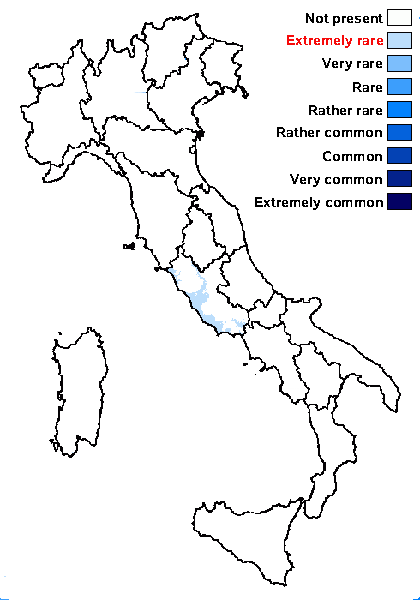Julella subericola (B. de Lesd.) ined.
(provisionally placed here, ICN Art. 36.1b). Basionym: Polyblastiopsis subericola B. de Lesd. - in Crozals, Ann. Soc. Hist. nat. Toulon , 10: 115, 1924
Synonyms:
Distribution: C- Laz (Ravera 2002b, 2008).
Description: Thallus crustose, not lichenized, endosubstratic, poorly evident, appearing as a whitish patch. Perithecia scattered, black, globose, 0.2-0.3 mm across, half-immersed, not covered by a layer of periderm, with an involucrellum. Exciple olivaceous green throughout, K+ greenish, N-; paraphyses branched and anastomosing, the hymenial gel non-amyloid. Asci 8-spored, cylindrical, the apex not thickened, c. 110 µm long. Ascospores at first 3-septate then muriform, with 2 longitudinal septa, hyaline, ellipsoid, 16-27 x 9-12 µm. Photobiont absent. Spot tests: thallus K-, C-, KC-, UV-. Chemistry: without lichen substances.Note: a very poorly known, non-lichenized species with a Mediterranean distribution, reported from southern France, Spain, and Central Italy. It grows on the bark of evergreen oaks, especially Q. suber. The inclusion in Julella, in itself a probably heterogeneous genus (see Thiyagaraja & al. 2021) is tentative, waiting for DNA sequencing.
Growth form: Fungus
Substrata: bark
Reproductive strategy: mainly sexual
Commonnes-rarity: (info)
Alpine belt: absent
Subalpine belt: absent
Oromediterranean belt: absent
Montane belt: absent
Submediterranean belt: absent
Padanian area: absent
Humid submediterranean belt: absent
Humid mediterranean belt: extremely rare
Dry mediterranean belt: extremely rare

Predictive model
Growth form: Fungus
Substrata: bark
Reproductive strategy: mainly sexual
Commonnes-rarity: (info)
Alpine belt: absent
Subalpine belt: absent
Oromediterranean belt: absent
Montane belt: absent
Submediterranean belt: absent
Padanian area: absent
Humid submediterranean belt: absent
Humid mediterranean belt: extremely rare
Dry mediterranean belt: extremely rare

Predictive model

